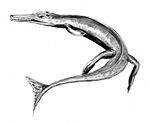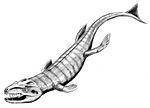Metriorhynchidae
| Metriorhynchids | |
|---|---|

| |
| Fossil of Cricosaurus, Museum Eichstaett | |
| Scientific classification | |
| Domain: | Eukaryota |
| Kingdom: | Animalia |
| Phylum: | Chordata |
| Class: | Reptilia |
| Clade: | Archosauria |
| Clade: | Pseudosuchia |
| Clade: | Crocodylomorpha |
| Clade: | Crocodyliformes |
| Suborder: | †Thalattosuchia |
| Clade: | †Euthalattosuchia |
| Family: | †Metriorhynchidae Fitzinger, 1843 |
| Subfamilies | |
| Synonyms | |
Metriorhynchidae is an
Description
Metriorhynchids are fully aquatic
Metriorhynchids were the only group of
Classification
The classification presented by Young and Andrade in 2009 was approved in later studies of the Metriorhynchidae.
| Metriorhynchidae |
| |||||||||||||||
List of genera
The type genus of the family Metriorhynchidae is Metriorhynchus from the Middle to Late Jurassic.[20] Other genera included within this family are Cricosaurus, Geosaurus, and Dakosaurus. Though once considered a metriorhynchid, Teleidosaurus has since been found to be slightly more distantly related to these animals within the superfamily Metriorhynchoidea.[21]
Within this family, the genus Neustosaurus and Enaliosuchus are considered nomen dubium ("doubtful name").[22]
The genus Capelliniosuchus was once thought to be a metriorhynchid similar to Dakosaurus.[23] However, it was later found to be a mosasaur.[24]
| Genus | Status | Author | Age | Location | Description | Synonyms | Images |
|---|---|---|---|---|---|---|---|
| Ambayrac, 1913 | late Oxfordian |
France. |
Sometimes considered to be a nomen dubium. |
      | |||
| Valid | Wagner, 1858 | middle Oxfordian to upper Valanginian |
Argentina, Chile, Cuba, England, France, Germany, Mexico, Russia and Switzerland. |
||||
| Valid | von Quenstedt, 1856 | upper Kimmeridgian to lower Berriasian |
Argentina, England, France, Germany, Mexico, Poland, Switzerland and possibly Russia. |
| |||
| nomen dubium[27] | Koken, 1883 | Valanginian |
Germany. |
||||
| Valid | Cuvier, 1824 | upper Kimmeridgian to upper Valanginian |
France, Germany, Italy and Switzerland. |
| |||
| Valid | Young et al., 2010 | middle Callovian to lower Kimmeridgian |
England and France. |
||||
| Valid | Parrilla-Bel et al., 2013 | middle Callovian to Kimmeridgian |
Spain and Mexico. |
||||
| Valid | von Meyer, 1832 | lower Kimmeridgian. |
France. |
| |||
| Valid | Cau & Fanti, 2011 | earliest Bathonian |
Italy. |
||||
| nomen dubium | Valanginian | — potential senior synonym of Enaliosuchus
|
|||||
| Valid | Owen, 1884 | late Kimmeridgian to early Tithonian |
England and possibly Spain. |
||||
| Valid | Rusconi, 1948 | upper Tithonian |
Argentina and Chile. |
||||
| Valid | von Meyer, 1831 | lower Tithonian |
Germany. |
||||
| Valid | Lydekker, 1890 | middle Callovian to lower Oxfordian |
England and France. |
||||
| Valid | Young et al., 2020 | lower Callovian to lower Oxfordian |
England and France. |
||||
| Valid | Andrade et al., 2010 | Kimmeridgian to Tithonian |
England. |
||||
| Valid | Young et al., 2013 | Callovian |
England. |
See also
References
- ^ Andrews CW. 1913. A descriptive catalogue of the marine reptiles of the Oxford Clay, Part Two. London: British Museum (Natural History), 206 pp.
- hdl:2318/1537833.
- ^ Fitzinger LJFJ. 1843. Systema Reptilium. Wien: Braumüller et Seidel, 106 pp.
- ^ .
- ^ .
- ^ Fraas E (1902). "Die Meer-Krocodilier (Thalattosuchia) des oberen Jura unter specieller Berücksichtigung von Dacosaurus und Geosaurus". Palaeontographica. 49: 1–72.
- ISSN 1094-8074.
- ^ a b Steel R. 1973. Crocodylia. Handbuch der Paläoherpetologie, Teil 16. Stuttgart: Gustav Fischer Verlag,116 pp.
- .
- ISBN 978-3-946705-07-9. Archived(PDF) from the original on 2023-05-17.
- ISBN 978-3-946705-07-9. Archived(PDF) from the original on 2023-05-17.
- ^ hdl:11336/137182.
- doi:10.4202/app.00801.2020. Archived from the original (PDF) on 2021-05-21.)
{{cite journal}}: CS1 maint: multiple names: authors list (link - ^ .
- ^ .
- ^ a b Mueller-Töwe IJ (2005). "Phylogenetic relationships of the Thalattosuchia". Zitteliana. A45: 211–213.
- S2CID 10312971.
- ^ .
- PMID 21543396.
- ^ doi:10.1093/zoolinnean/zlaa092.)
{{cite journal}}: CS1 maint: multiple names: authors list (link - .
- ^ Buffetaut E (1982). "Radiation évolutive, paléoécologie et biogéographie des Crocodiliens mésosuchienes". Mémoires de la Société Géologique de France. 142: 1–88.
- ^ Simonelli V (1896). "Intoro agli avanzi di coccodrilliano scoperti a San Valentino (provincial di Reggio Emilia) nel 1886". Atli della Reale Accademia dei Lincei, Series Qunita Rendiconti. 5 (2): 11–18.
- ISSN 0195-6671.
- ^ Quenstedt FA. 1856. Sonst und Jetzt: Populäre Vortäge über Geologie. Tübingen: Laupp, 131.
- ^ Koken E (1883). "Die reptilian der norddeutschen unteren Kreide". Zeitschrift der Deutschen Geologischen Gesellschaft. 35: 735–827.
- S2CID 218996914.)
{{cite journal}}: CS1 maint: multiple names: authors list (link - ^ Cuvier G. 1824. Sur les ossements fossiles de crocodiles, 5. In: Dufour & D'Occagne, eds. Recherches sur les ossements fossiles, 2nd édition. Paris: 143-160
- doi:10.1111/j.1096-3642.2009.00571.x.)
{{cite journal}}: CS1 maint: multiple names: authors list (link - S2CID 83985855.
External links
- "Crocodilia: Crocodyliformes (Gobiosuchids, Teleosaurs & Metriorhynchids)". Palaeos. Archived from the original on 2023-02-17.
